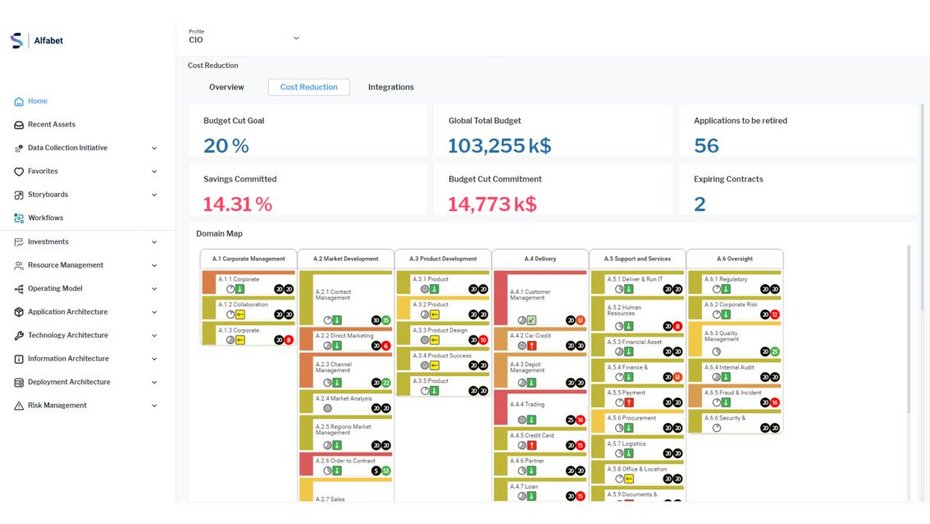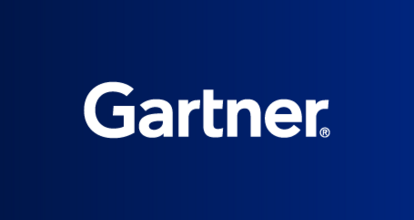Overview
As a C-level executive in charge of one of the company’s most mission-critical assets—information technology—your peers expect you to align seamlessly with corporate strategy and maintain total control over the IT landscape and execution. However, keeping pace with business change is often hindered by a lack of understanding of business direction, inadequate governance, and insufficient tools for managing an IT plan. Additionally, poor coordination between business and IT can lead to frustration among business peers due to insufficient functionality, lack of IT agility, and missed project deadlines. Consequently, IT is often criticized for not delivering value for money.
Help is here: CIOs of leading international companies are using strategic portfolio management (SPM) and enterprise architecture (EA) capabilities to ensure effective communication between business and IT, with the CIO's office orchestrating business and IT decision-making. Interested in learning how?
The challenges of keeping in step with business
As a CIO, you need to establish governance and processes to proactively manage the business-IT relationship and understand the business direction. Without this, aligning the business and efficiently using the IT budget becomes impossible. Equally important is ensuring that enterprise architects, IT strategists, planners and the EPMO are coordinated and have the transparency required to deliver on business needs—cost effectively and with risk awareness. However, several challenges need to be addressed.
Is the business you are serving understood?
The business models, strategies, goals, capabilities and processes you support must be expressed in common business terms. Gaps in IT support should be articulated as demands. If not, you cannot align IT with the business.
Do your IT planners and strategists have the means to enable business strategy?
They need to design and present strategic scenarios and IT road maps in a format that business can understand and approve. If not, the business will not buy into your IT plans.
Is there integrated planning and architecture governance in place?
Business demands need to be translated into executable, approved projects, with due diligence performed on every demand to prevent project failure. If not, you will waste IT investment budgets.
Are application and technology portfolios being proactively managed?
You need to ensure IT is agile, cost effective, and risk aware with transparency over costs and risks. If not, IT operations spending will be wasted.
To overcome the challenges of translating demand into IT reality, CIOs need to integrate people, processes and information to introduce the necessary governance and transparency into the business-IT relationship.

Meeting these challenges with SPM and EA
With SPM and EA, best-in-class CIOs implement the necessary processes and governance into the business-IT relationship and IT planning and management. By doing so, they support different stakeholders with core capabilities to meet the challenges of keeping in step with business:
- What business demand exists?
- Are programs contributing to strategy?
- Are IT investments and running costs optimized?
- Can you be sure that IT will deliver?
These key questions are answered through the following essential capabilities:
Business strategic planning
This capability structures and analyzes business strategies, business models, processes and required business capabilities in a structured and analyzable form.
Business-IT relationship management
This provides a process-supported single point of business demand capture and prioritization. Demands can be associated with IT strategies and roadmaps for impact analysis, forming the foundation for optimum business-IT alignment.
IT planning
IT planning converts business demands into executable and funded IT programs. It enables target architectures and scenarios to be iterated with business and minimizes IT project risks. The road-mapping features support decisions on roll-out strategies, and project portfolio capabilities optimize IT investment.
Enterprise architecture management
Enterprise architecture management supports the implementation of standards and governance needed to optimize applications and technology portfolios. It also provides analytical insight into the strengths and weaknesses of current IT support—thus enabling mid- and long-term improvement in terms of cost, risk and agility.
IT financial management
Financial transparency across the IT landscape supports sound business decisions on IT. IT finance management provides this transparency with cost-driver analysis to highlight areas for cost optimization, leading to significant savings in OpEx and CapEx.
IT risk management
To ensure smooth business transformation and to avoid IT security incidents, CIOs need IT risk transparency. IT risk management provides the necessary process support to integrate and assess the information relevant for effective risk management of IT assets and fulfillment of compliance requirements. This should be in an automated form to reduce the costs of risk management and compliance.
Leader in SPM and EA
Internationally renowned companies across the globe use the market-leading solution for SPM and EA—Alfabet. The platform provides a set of core capabilities to sustainably manage and ensure IT’s contribution to business value. SPM and EA aim to plan and monitor the performance of IT support throughout its entire life cycle—ensuring that business strategy and demands are fully understood, prioritized and executed, and that the costs, quality and risks to IT support are known and considered during decision making.
Management uses Alfabet for continuous course corrections. In it, they can look at all the strategic assets, the ones in which we have invested a lot of money and assess it across parameters such as usage, seats available, and uptime. With this you loosely see if you’re getting to management’s target state and what the gaps are.
About Alfabet
Alfabet is a leading enterprise platform with standard modules that support effective Strategic Portfolio Management (SPM) and EA, offering:
- The richest set of artifacts in the industry
- A single, central repository
- Role-based access and support for global communities
- Decision-ready reporting and publication
- Advanced support for the agile enterprise
- Broad and easy-to-use configuration
- Use of leading-edge AI technologies
- Support for federated enterprises



